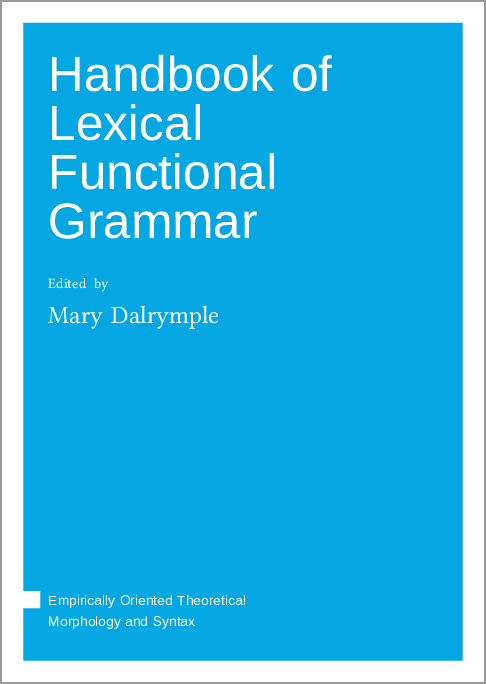We log anonymous usage statistics. Please read the privacy information for details.
Handbook of Lexical Functional Grammar
Synopsis
Lexical Functional Grammar (LFG) is a nontransformational theory of
linguistic structure, first developed in the 1970s by Joan Bresnan and
Ronald M. Kaplan, which assumes that language is best described and
modeled by parallel structures representing different facets of
linguistic organization and information, related by means of
functional correspondences. This volume has five parts. Part I,
Overview and Introduction, provides an introduction to core syntactic
concepts and representations. Part II, Grammatical Phenomena, reviews
LFG work on a range of grammatical phenomena or constructions. Part
III, Grammatical modules and interfaces, provides an overview of LFG
work on semantics, argument structure, prosody, information structure,
and morphology. Part IV, Linguistic disciplines, reviews LFG work in
the disciplines of historical linguistics, learnability,
psycholinguistics, and second language learning. Part V, Formal and
computational issues and applications, provides an overview of
computational and formal properties of the theory, implementations,
and computational work on parsing, translation, grammar induction, and
treebanks. Part VI, Language families and regions, reviews LFG work
on languages spoken in particular geographical areas or in particular
language families. The final section, Comparing LFG with other
linguistic theories, discusses LFG work in relation to other
theoretical approaches.
Chapters
-
PART I: OVERVIEW AND INTRODUCTION
-
Introduction to LFG
-
Core concepts of LFG
-
Grammatical functions in LFG
-
PART II: GRAMMATICAL PHENOMENA
-
Anaphora
-
Agreement
-
Case
-
Complex predicates
-
Coordination
-
Clause structure and configurationality
-
Unbounded dependencies
-
Negation
-
Noun phrases in LFG
-
Pronoun incorporation
-
Raising and control
-
PART III: GRAMMATICAL MODULES AND INTERFACES
-
Glue Semantics
-
Argument structure and mapping theory
-
Prosody and its interfaces
-
Information structure
-
Morphology in LFG
-
PART IV: LINGUISTIC DISCIPLINES
-
LFG and historical linguistics
-
LFG, Optimality Theory and learnability of languages
-
PART V: FORMAL AND COMPUTATIONAL ISSUES AND APPLICATIONS
-
Formal and computational properties of LFG
-
Computational implementations and applications
-
Treebank-driven parsing, translation and grammar induction using LFG
-
LFG treebanks
-
PART VI: LANGUAGE FAMILIES AND REGIONS
-
LFG and African languages
-
LFG and Australian languages
-
LFG and Austronesian languages
-
LFG and Celtic languages
-
LFG and Continental West Germanic languages
-
LFG and Finno-Ugric languages
-
LFG and Romance languages
-
LFG and Scandinavian languages
-
LFG and Semitic languages
-
LFG and Sinitic languages
-
LFG and Slavic languages
-
PART VII: COMPARING LFG WITH OTHER LINGUISTIC THEORIES
-
LFG and Cognitive and Constructional Theories
-
LFG and Dependency Grammar
-
LFG and HPSG
-
LFG and Minimalism
-
LFG and Role and Reference Grammar
-
LFG and Simpler Syntax
-
LFG and Tree Adjoining Grammar
-
Glossary




